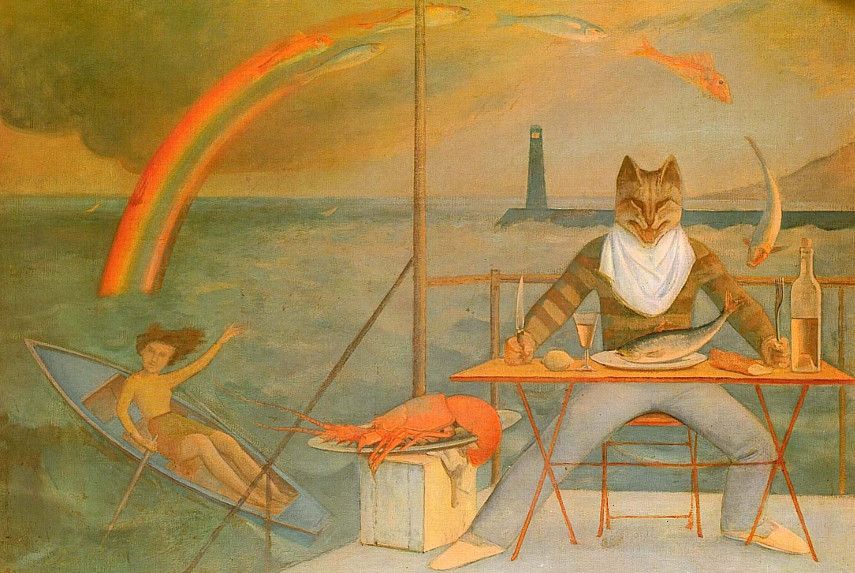About a Girl - Why Balthus' "Therese Dreaming" Painting Shook The Met Museum Visitors
Official reports state that the Metropolitan Museum of Art in New York has decided not to remove the Thérèse Dreaming painting made by Balthus in 1938, despite the fact the online petition that called out the artwork as too sexually suggestive gathered almost 9000 backers[1] determined to see the piece gone from public view.
The painting in question depicts Balthus’ favored model and neighbor Thérèse Blanchard reclining in a chair in a suggestive pose that leaves her underwear visible. This would be, of course, a universally accepted example of a fine artwork if it wasn't for the fact the girl in question was 12 or 13 years old at the time of the painting's creation.
Although it looked as if the petitioners were optimistic about their chances of taking down or at least censoring the piece to some extent, the Metropolitan Museum of Art stated that there was no room for compromise and that Thérèse Dreaming will remain where it is and as it is for the time being.

The Controversy Surrounding Balthus' Art and Life
Thérèse Dreaming is not the only painting Balthasar Klossowski made during his lifetime that stirred up a decent amount of controversy. For more than six decades, until his death in 2001 to be more precise[2], Balthus depicted young woman on canvases, many of which were presented in provocative poses.
Another perennial motif found throughout this painter's body of work are cats, his totem animals many believe were used as a way for Balthus to include his spirit into paintings.
A largely self-taught painter who learned what he needed from copying frescoes in Italy, Balthus based so much of his practice on controversial depictions of young girls that it seems almost every single debate about his works ends up with talks about perversity.
Although these claims were always just speculations and theories, the apparent eroticism and voyeurism present in Balthus' artworks just rub some people the wrong way.
As a result of such a practice, the artworks of Balthus saw their fair share of controversies over the years - the current issue with the painting is just another instance in a long line of problematic events surrounding the painter.

Thérèse Dreaming
Before we take a closer look at the painting in question, it should be noted that Thérèse Dreaming is one of the most well-persevered Balthus works in terms of colors and the sharpness of the lines, two aspects of his paintings that did not age particularly well with other artworks.
Balthus met Therese Blanchard in the year of 1936. She was an eleven-year-old daughter of a restaurant worker who lived next to Klossowski. Captivated by the little girl, Balthasar made ten paintings of her during the next three years, pieces that are now considered to be the man's finest work. This series captures the moods of adolescent girlhood, something Balthasar Klossowski probably identified with to some extent[3].
In this piece, the young girl is presented lost in thought. Sitting in a chair and relaxing, the twelve or thirteen-year-old appears to be alone in a room with a cat. Although the pose in which the girl is depicted does reveal her underwear, there's no other indicator of any sexual context whatsoever.

The New Petition Against the Painting
The petition against the artwork was originally started by a New York resident Mia Merrill on the 30th of November 2017. She explained the reasoning behind the protest with the following statement:
The artist had a noted infatuation with pubescent girls, and it can be strongly argued that this painting romanticizes the sexualisation of a child. In showcasing this work for the masses without providing any type of clarification, the Met is, perhaps unintentionally, supporting voyeurism and the objectification of children.
The petition gathered more than 8,600 supporters since the time of its launch and it seems a fairly big number of people agrees with Merrill's point of view. It should be noted that neither Mia Merrill nor any of the backers asked for the painting to be "censored, destroyed or never seen again", but rather to be removed from display or shown with a caption that acknowledges the controversy of what's depicted on the canvas.
We'll leave to your judgment just how appropriate and sensible it truly is to put Some of the paintings in this exhibition may be disturbing to some visitors on Balthus' paintings.

The Metropolitan Museum of Art's Response
After carefully examining the accusations behind the petition, the Metropolitan Museum of Art's chief communications officer Kenneth Weine stated the following:
Moment such as this provides an opportunity for discussion, and visual art is one of the most significant means we have for reflecting on both the past and the present and encouraging the continuing evolution of existing culture through informed conversation and respect for creative expression.
However, the representatives of the popular Met were clear on one thing - they will not add any written warnings to the piece and it will certainly not be removed from the institution's public collection.
Although they encourage the public to give their opinions and views on what's in the museum, the officials did not find enough evidence in the accusations to warrant a removal or to in any way restrict the controversial painting's availability.
Editors’ Tip: Balthus: Cats and Girls
Balthus’s lifelong curiosity about the ambiguities and dark side of childhood resulted in his best-known and most iconic works. In these pictures, Balthus (1908-2001) mingles intuition into his young sitters’ psyches with overt erotic desire and forbidding austerity, making them among the most powerful depictions of childhood and adolescence ever committed to canvas. Often included in these scenes are enigmatic cats, possible stand-ins for the artist himself. Balthus: Cats and Girls is the first book devoted to this subject, focusing on the early decades of the artist’s career from the mid-1930s to the 1950s.
References:
- Libbey, P., December 4, 2017, Met Defends Suggestive Painting of Girl After Petition Calls for Its Removal, The New York Times [Dec 6, 2017]
- Russell, J., February. 19, 2001, Balthus, Painter Whose Suggestive Figures Caused a Stir, Is Dead at 92, The New York Times [Dec 6, 2017]
- Cruz, C., November 26, 2013, Balthus’s Androgynous Dreams, Hyperallergic [Dec 6, 2017]
Featured image: Balthus - Thérèse, 1938 (detail), via metmuseum.org; Balthus - The Golden Years, c.1945, via wikiart.org; Balthus - Nude with Cat, 1949, via wikiart.org. All images used for illustrative purposes only.
Can We Help?
Have a question or a technical issue? Want to learn more about our services to art dealers? Let us know and you'll hear from us within the next 24 hours.

